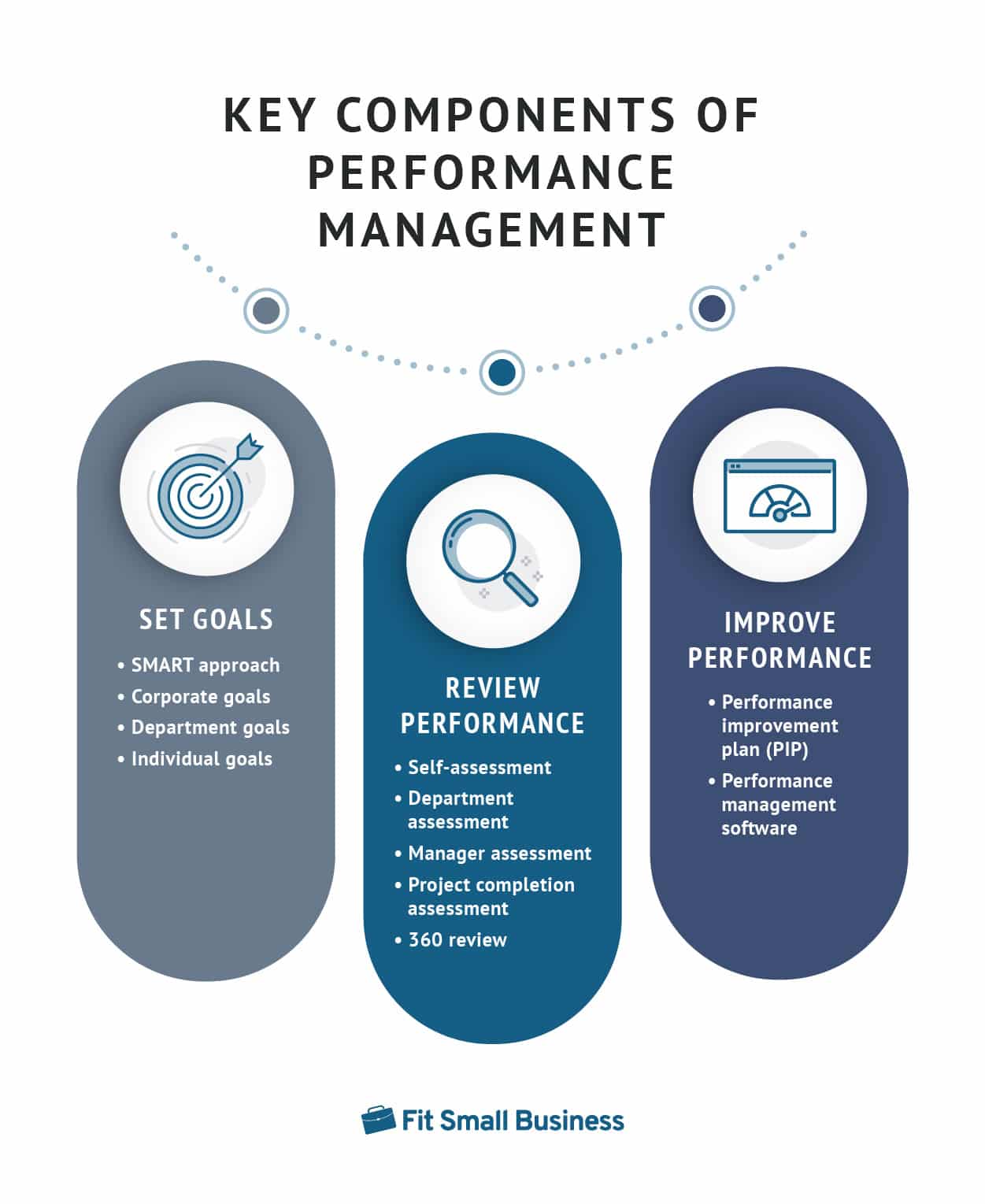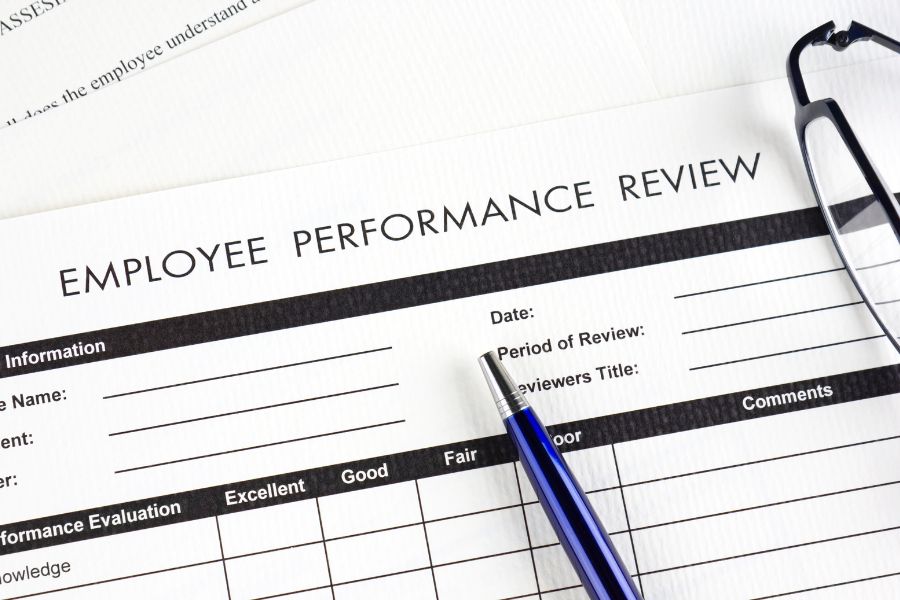Employee performance management describes how you manage your employees’ work performance, with the process and tools you use to do this making up your performance management system. The goal of an effective performance management process is to engage employees and enable them to thrive and produce high-quality work.
There are ways to best achieve this result. A simplified approach is to set overall company goals, narrow these to department-level goals, and then further into individual contributor goals. You’ll then evaluate your employees’ progress toward hitting those goals and provide feedback and tools to improve that progress.
Key Takeaways
- Set goals, review, and improve performance
- Clearly communicate expectations to employees
- Train employees and managers to increase performance
How Performance Management Works
Performance management is the process of improving performance through the use of tools, evaluation, coaching, counseling, and providing essential feedback. To fully understand what performance management is, you must look into the key components involved—setting goals, reviewing performance, and improving the performance.

Set Goals
To ensure your team performs at optimal levels, setting precise goals at the beginning is crucial. Without goals at every level, effective performance management fails. We recommend using a specific method to create these goals, known as the SMART approach:
- Specific
- Measurable
- Attainable
- Relevant
- Time-bound
This strategy will not only help focus your team members on strategic objectives for your business but will also help make your goals clear and attainable. For a more detailed guide on how to create these, check our SMART goals guide.
Review Performance
A performance review is the process of assessing an employee’s progress toward a stated goal and their successful completion of the goal. Only after you have created the goals for each employee can you review their performance.
Check out our performance review guide and download a free evaluation template if you’re not using performance management software.
Performance reviews generally occur at regular intervals throughout the year and often play a part in whether an employee gets promoted or receives a raise. To ensure that your performance reviews have structure and provide benefits to everyone involved, here are some suggestions for different types of systems to use. These systems are not mutually exclusive and can be combined to create an even more effective performance review system.
Not conducting performance reviews ignores your employees’ desire to do good work. Without performance reviews, employees don’t know if they’re hitting the mark or not. Other problems you should avoid when doing performance reviews include:
- Infrequent Reviews: Providing feedback in real time is important, but having regular, structured reviews enables you to collect data for your conversations with employees. If you don’t have regular conversations, your employees don’t know what to expect.
- Lack of Honesty: To provide effective feedback to employees, you have to be honest with them, even when that means delivering uncomfortable news. Too many managers simply rate employees the same, resulting in ineffective messaging.
Improve Performance
The only way to improve the performance of an employee is to give them every chance of success. If you haven’t been clear about expectations and haven’t set measurable and achievable goals, reprimanding an employee for not meeting expectations will backfire.
We recommend a measured approach to improve employee performance. You should have a process outlined in your corporate employee handbook so your employees know what to expect, while also giving you a guide to follow.
Make sure to always start it out with a clear discussion. If you notice a problem with an employee, or if they come to you with an issue that may prevent them from meeting a deadline or otherwise completing a project on time, discuss it immediately. You may be able to offer guidance or make adjustments to a project that can help your employee achieve success.
Performance Management Tips
Improving performance management involves encouraging employees, focusing on communication, and measuring successes. You can achieve this by doing the following:
- Provide coaching: Your managers may not automatically know how to manage the performance of their team members. By providing coaching and training resources, you can ensure your managers are equipped with the right tools to successfully motivate their employees’ to perform. Check out our guide on how to coach employees, as well as our list of the best personnel training software for some ideas on how to approach this.
- Focus on strengths: It’s important to address areas of needed improvement, however, by acknowledging your employees’ strengths you create an atmosphere of respect and motivation.
- Clearly communicate: Employees need to understand their expectations and goals in order to perform at their best. When managers clearly communicate with their team members they are better able to offer support when needed.
- Measure success: Employees tend to thrive when they have clear objectives. By measuring their success their progress can be tracked allowing them to better achieve their goals.
Performance Management Tools
Performance management is more than just reviewing your employees’ performance with annual reviews. There are tools available to help you keep a pulse on your employees all year long.
Tool | Description |
|---|---|
KPIs | Using key performance indicators (KPIs) can help you manage the performance of all your employees with measurable data. |
Surveys | You can receive excellent feedback into the performance of your employees through the use of anonymous surveys. Read our guide to creating employee surveys to learn how to do it on your own. |
Training | When you keep your employees’ skills updated with learning and development resources, you can gauge their performance based on the skills they are learning. |
OKRs | Using objectives and key results (OKRs) can help you determine where your employees’ performance is excelling and where they may need to improve. |
Appraisals | A performance appraisal (also known as a review) is a great way to gather feedback from your employees on their perceived performance and discuss ways to correct inconsistencies. |
Need an all-in-one solution to approach performance management? Check out our roundup of the best performance management systems—these can help grease the process and ensure nothing slips through the cracks.
How Performance Management Helps Your Business
When done correctly, performance management can help your business thrive by providing your employees with clear goals, addressing issues at the moment, and helping them flourish through effective performance improvement. A structured performance management system provides your company:
- Clear corporate, departmental, and individual goals
- A defined process to follow for holding employees accountable
- The ability to increase employee morale and engagement
- Objective views on both individual and team performance
Through a quality performance management system, you can increase employee engagement, which increases employee productivity and ultimately helps boost your company profits. This allows you to provide additional employee benefits, attracting more high-quality employees and further growing your company. It’s a cycle that keeps repeating, with performance management at the center of it all.
Legal Considerations
There are some potential legal issues with performance management systems, but it’s important to note that there is no federal law requiring private companies to provide employees with a review. While that may be the case, not doing so could have negative consequences for employee morale and engagement.
Besides that, it’s important to note that federal, state, and local laws do require you to not discriminate against anyone in the workplace. Title VII of the Civil Rights Act of 1964 prohibits discrimination based on an employee’s:
- Race
- Color
- Religion
- Sex
- National origin
Given that, your performance management system must adhere to these employment laws. Your performance management process cannot discriminate against any employee or violate any other state and federal employment laws and regulations. Having a structured policy and process can help you avoid legal issues and costly fines.
Bottom Line
A top-notch performance management system proactively involves employees in the process. Starting with your corporate goals, you can track the required work down to the individual team member level, using a structured method that provides your employees with clear objectives showing them exactly how to succeed. Effective employee management is not coming down hard on your employees but rather giving them the tools and the insight they need to succeed.

